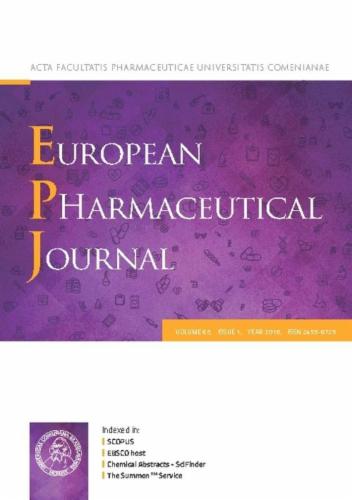基于搅拌诱导聚集倾向的治疗蛋白分层聚类及其与理化参数的关系
IF 4.3
3区 医学
Q1 PHARMACOLOGY & PHARMACY
引用次数: 0
摘要
焦虑等生理压力会诱导蛋白质聚集,从而对患者的免疫系统产生不利影响,从而给药物开发带来挑战。通过配方优化可以使物理应力引起的团聚最小化。在本研究中,制备了10种治疗蛋白和12种不同配方(4种pH条件和3种盐浓度)的120种组合。随后,通过使用尺寸排除色谱法评估其单体回收率(%)来研究每种蛋白质的搅拌诱导聚集倾向。根据蛋白质的聚集倾向,采用分层聚类方法对蛋白质进行分类,得到A和b两组蛋白质。A组蛋白质的聚集倾向对配方条件的变化不敏感,因为pH和盐浓度的变化对构象、胶体和界面稳定性的影响最小,构象和胶体稳定性之间存在补偿机制。因此,A组蛋白的配制具有较高的自由度。B组蛋白的聚集倾向对配方条件的变化较为敏感。对B组蛋白理化参数和单体回收率的多元回归分析表明,单体回收率对配方变化的敏感性主要是由于构象稳定性随配方变化而变化。对于所有抗体,搅拌后的单体回收率与40°C静置1个月后的单体回收率呈正相关,这表明无需静置测试即可获得稳定的配方。因此,提出的基于搅拌诱导单体回收的配方优化策略可以提高选定治疗蛋白的配方效率。这种战略方法有望加速治疗性蛋白的开发,同时反映聚集因子和静止稳定性在优化治疗性蛋白配方中的重要性。本文章由计算机程序翻译,如有差异,请以英文原文为准。

Hierarchical clustering of therapeutic proteins based on agitation-induced aggregation propensity and its relation to physicochemical parameters
Physical stresses such as agitation induce protein aggregation, which causes adverse effects on the immune system of patients, leading to challenges in drug development. Aggregation induced by physical stresses can be minimized by formulation optimization. In this study, 120 combinations of 10 therapeutic proteins and 12 different formulations (4 pH conditions and 3 salt concentrations) were prepared. Subsequently, the agitation-induced aggregation propensity of each protein was investigated by evaluating its monomer recovery (%) using size exclusion chromatography. Hierarchical clustering was applied to categorize each protein according to its aggregation propensity, resulting in two groups of proteins: group A and B. The aggregation propensity of proteins in group A was insensitive to changes in formulation conditions because conformational, colloidal, and interfacial stabilities were minimally affected by changes in the pH and salt concentration and a compensation mechanism existed between conformational and colloidal stabilities. Thus, proteins in group A can be formulated with a relatively high degree of freedom. In contrast, the aggregation propensity of proteins in group B was sensitive to changes in formulation conditions. Multiple regression analysis of the physicochemical parameters and monomer recovery of proteins in group B clarified that changes in conformational stability in response to changes in formulations primarily contributed to the sensitivity of the monomer recovery to changes in formulation conditions. For all antibodies, there was a positive correlation between the monomer recovery after agitation and that after quiescent storage at 40 °C for 1 month, suggesting that a stable formulation can be obtained without the quiescent testing. Therefore, a proposed formulation optimization strategy based on the agitation-induced monomer recovery can improve the efficiency of formulating selected therapeutic proteins. This strategic approach is expected to accelerate the development of therapeutic proteins while reflecting the importance of aggregation factors and quiescent stability in the optimization of therapeutic protein formulations.
求助全文
通过发布文献求助,成功后即可免费获取论文全文。
去求助
来源期刊
CiteScore
9.60
自引率
2.20%
发文量
248
审稿时长
50 days
期刊介绍:
The journal publishes research articles, review articles and scientific commentaries on all aspects of the pharmaceutical sciences with emphasis on conceptual novelty and scientific quality. The Editors welcome articles in this multidisciplinary field, with a focus on topics relevant for drug discovery and development.
More specifically, the Journal publishes reports on medicinal chemistry, pharmacology, drug absorption and metabolism, pharmacokinetics and pharmacodynamics, pharmaceutical and biomedical analysis, drug delivery (including gene delivery), drug targeting, pharmaceutical technology, pharmaceutical biotechnology and clinical drug evaluation. The journal will typically not give priority to manuscripts focusing primarily on organic synthesis, natural products, adaptation of analytical approaches, or discussions pertaining to drug policy making.
Scientific commentaries and review articles are generally by invitation only or by consent of the Editors. Proceedings of scientific meetings may be published as special issues or supplements to the Journal.

 求助内容:
求助内容: 应助结果提醒方式:
应助结果提醒方式:


